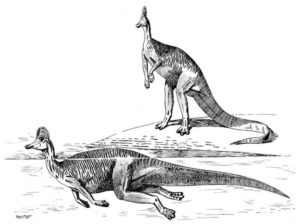Dec
12
New Duck-Billed Dinosaur in Missouri
“Show… me… the fossils!” — me, with apologies to Jerry Maguire and Rod Tidwell
And by “new” I mean the remains of a newly-discovered species, not a newly-evolved creature that was found munching away in some marshlands. But, you probably knew that…

Even if you aren’t into paleontology that much, you may remember seeing hadrosaurs, those 25-30 foot long herbivores with mouth and snout shaped like a duckbill, in the Jurassic Park movies or computer games. Among the hadrosaurids are many genera, including Parrosaurus (aka Hypsibema) from the Late Cretaceous Period. The species Parrosaurus missouriensis is the subject of this week’s post.
When fossil researcher Guy Darrough unearthed dinosaur remains at a uniquely fruitful site in southern Missouri, he contacted both Chicago’s Field Museum and the Sainte Genevieve Museum Learning Center. Researchers from both organizations converged on the dig, confirmed that Darrough had found a juvenile hadrosaur, and then found an adult of the same species. Specifically, the fossils were from the Parrosaurus missouriensis, which happens to be the official state dinosaur of Missouri.
The discovery site has been described by Pete Makovicky, a professor at University of Minnesota and curator of dinosaurs at the Field Museum, as “one of the best dinosaur localities east of the Great Plains.” Dinosaur bones were first discovered on the property in the 1940s when the original owners were digging a well, and those bones were sent to the Smithsonian, where they were (as so often happens) promptly shelved and forgotten. The property was sold in the 1970s (or 1980s?), a second set of bones was discovered, and paleontological digs (often by amateurs) have been nearly ongoing ever since.
Excavation of this particular site has been underway since 2017, but delays for reasons ranging from soft, wet clay to pandemic concerns has made it slow-going. Researchers have also found remains from several huge turtles, prehistoric fish, huge crocodiles, and “parts from at least four different dinosaurs, including [a tooth from a Tyrannosaurus and] a juvenile dinosaur of the same [duck-billed] species found in the early 2000s.” The Parrosaurus missouriensis fossils comprise the only such discovery in the US, and it is now officially considered a new species.
As the learning center’s Abigail Kern told Newsweek, the adult specimen is going to the Field Museum in Chicago, while the juvenile skeleton will be on display within the laboratory of the Sainte Genevieve Museum Learning Center.

“We currently have the fossil displayed in the plaster jacket. Starting on the date of our Grand Opening, December 11, we will have paleontologists and preparers actively working on the fossil within the lab, which is viewable in our museum.”
Considering the various findings unearthed in this particular area (as yet undisclosed to the public), researchers are hopeful of making several more discoveries — including more P. missouriensis specimens — as the dig continues. Makovicky postulates,
“We actually have something that’s probably a mass death locality, where we have a herd of dinosaurs dying and being sort of buried together, and individuals of different ages. We can start looking at how these dinosaurs grew, start to understand a little bit about their biology and their possible herd structure. And that’s unique for a site east of the Great Plains. Most of what we know about the North American dinosaur comes from out west.”
Sounds like exciting times for North American paleontologists, especially in the “Show me” state!It’s also an opportunity to discover more about these intriguing creatures that God put here on Earth so many millions of years ago!
P.S. You can view a brief news piece on the discovery here.















